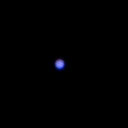This week Mercury will be exiting the dawn sky, sliding closer to the Sun in our sky each day. It will pass through superior conjunction on May 27th, heading for an evening apparition beginning in the first days of June.
Category: Planet Events
The Moon and Saturn
Saturn, the Moon and Spica will rise together in the east after sunset this evening. The three will be within 10° of each other. The Moon will be just short of full, over 94% illuminated as it rises. Saturn will be shining at 0.4 magnitude while Spica is very close to 1.0 magnitude.
Tomorrow night will see the Moon east of Saturn, but still close, just over 10°.
Jupiter Exits the Evening Sky
This week sees Jupiter disappear into the sunset. The planet will pass through superior conjunction on May 13th, to reappear in the dawn during the last days of May.
The Moon and Venus
A pretty crescent Moon will join Venus in the evening sky tonight. The pair will be a little less than 6° apart with a 13% illuminated Moon. It should make a lovely pairing high in the dusk.
The Moon and Jupiter
This evening will see a razor thin Moon just above the planet Jupiter, low in the sunset. The planet will be about 5° below a 3% illuminated Moon. The Moon itself will be only 19° from the Sun at sunset, about 18:42HST. It should be a dramatic scene with the pair immersed in the colors of sunset.
Mercury and Uranus
Mercury and Uranus will meet up in the dawn over the next few days. The pair is separated by about 3° this morning. Tomorrow morning the separation will have diminished to about 2°19′. Close approach will be on the morning of April 22nd at almost exactly 2°. On the 23rd the separation will have increased to 2°14′. Both planets will be well up, about 17° elevation at sunrise.
While Mercury is easy to pick out with the unaided eye. Uranus will require at least a pair of binoculars to see at 5.9 magnitude. The close approach will aid in finding the outer planet. Check your charts, there are a couple 6th magnitude stars just as close to Mercury to confuse for the dimmer planet.
Mercury at Maximum Elongation
Today Mercury reaches maximum elongation, the furthest point it will reach from the Sun in the sky and the highest it will be above the sunrise for this morning apparition. The planet is easily visible as a bright, starlike object about 15° above the rising Sun as the twilight begins. Over the next couple weeks Mercury will slide back into the sunrise, heading for superior conjunction on May 27.
A Thin Moon and Mercury
Tomorrow morning a thin Moon will join Mercury in the dawn. The 6.5% illuminated moon will be a bit over 6.5° from the planet. The pair will be over 15° above the horizon at sunrise. The planet Uranus is only 4.5° from Mercury, but at magnitude 5.9 it will be difficult to spot, even with a telescope, in the bright dawn.
Saturn at Opposition
This morning, at 07:44HST, the planet Saturn will pass through opposition. Earth will pass between the outer planet and the Sun. During this time Saturn rises at sunset, transits at midnight and sets at dawn. The planet is perfectly placed for observation, high in the sky, for much of the night. You can find Saturn in Virgo, five degrees from the bright star Spica.
For a few days before and after opposition the planet and it’s rings will be a bit brighter, an effect called, appropriately enough, the opposition effect. This is because we are directly in line with the Sun and planet, minimizing any shadows on the planet and in the rings.
Uranus Appears in the Dawn

